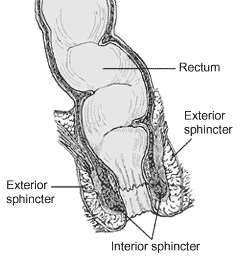Anorectal manometry
A diagnostic test to evaluate the function of the muscles in the rectum and anus
Anorectal Manometry[edit | edit source]
Anorectal manometry is a diagnostic procedure used to evaluate the function of the muscles in the rectum and anus. This test is particularly useful in assessing conditions related to defecation disorders, such as fecal incontinence and constipation.
Purpose[edit | edit source]
The primary purpose of anorectal manometry is to measure the pressures of the anal sphincter muscles, the sensation in the rectum, and the neural reflexes that are necessary for normal bowel movements. It helps in diagnosing conditions like Hirschsprung's disease, anismus, and other anorectal disorders.
Procedure[edit | edit source]
During the procedure, a small, flexible tube with a balloon at the end is inserted into the anus and rectum. The balloon is inflated, and the pressures exerted by the muscles are recorded. The test typically lasts about 30 minutes and is performed on an outpatient basis.
Indications[edit | edit source]
Anorectal manometry is indicated for patients experiencing:
- Chronic constipation
- Fecal incontinence
- Difficulty in passing stool
- Suspected Hirschsprung's disease
Interpretation[edit | edit source]
The results of anorectal manometry provide information about:
- Anal sphincter pressure
- Rectal sensation
- Rectoanal inhibitory reflex
- Coordination of the muscles during defecation
Abnormal results may indicate dysfunction in the anal sphincter muscles or nerve supply, which can guide further treatment options.
Related pages[edit | edit source]
Search WikiMD
Ad.Tired of being Overweight? Try W8MD's physician weight loss program.
Semaglutide (Ozempic / Wegovy and Tirzepatide (Mounjaro / Zepbound) available.
Advertise on WikiMD
|
WikiMD's Wellness Encyclopedia |
| Let Food Be Thy Medicine Medicine Thy Food - Hippocrates |
Translate this page: - East Asian
中文,
日本,
한국어,
South Asian
हिन्दी,
தமிழ்,
తెలుగు,
Urdu,
ಕನ್ನಡ,
Southeast Asian
Indonesian,
Vietnamese,
Thai,
မြန်မာဘာသာ,
বাংলা
European
español,
Deutsch,
français,
Greek,
português do Brasil,
polski,
română,
русский,
Nederlands,
norsk,
svenska,
suomi,
Italian
Middle Eastern & African
عربى,
Turkish,
Persian,
Hebrew,
Afrikaans,
isiZulu,
Kiswahili,
Other
Bulgarian,
Hungarian,
Czech,
Swedish,
മലയാളം,
मराठी,
ਪੰਜਾਬੀ,
ગુજરાતી,
Portuguese,
Ukrainian
Medical Disclaimer: WikiMD is not a substitute for professional medical advice. The information on WikiMD is provided as an information resource only, may be incorrect, outdated or misleading, and is not to be used or relied on for any diagnostic or treatment purposes. Please consult your health care provider before making any healthcare decisions or for guidance about a specific medical condition. WikiMD expressly disclaims responsibility, and shall have no liability, for any damages, loss, injury, or liability whatsoever suffered as a result of your reliance on the information contained in this site. By visiting this site you agree to the foregoing terms and conditions, which may from time to time be changed or supplemented by WikiMD. If you do not agree to the foregoing terms and conditions, you should not enter or use this site. See full disclaimer.
Credits:Most images are courtesy of Wikimedia commons, and templates, categories Wikipedia, licensed under CC BY SA or similar.
Contributors: Prab R. Tumpati, MD

